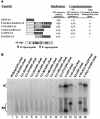Complementation of a deletion in the rubella virus p150 nonstructural protein by the viral capsid protein
- PMID: 12915564
- PMCID: PMC187411
- DOI: 10.1128/jvi.77.17.9502-9510.2003
Complementation of a deletion in the rubella virus p150 nonstructural protein by the viral capsid protein
Abstract
Rubella virus (RUB) replicons with an in-frame deletion of 507 nucleotides between two NotI sites in the P150 nonstructural protein (DeltaNotI) do not replicate (as detected by expression of a reporter gene encoded by the replicon) but can be amplified by wild-type helper virus (Tzeng et al., Virology 289:63-73, 2001). Surprisingly, virus with DeltaNotI was viable, and it was hypothesized that this was due to complementation of the NotI deletion by one of the virion structural protein genes. Introduction of the capsid (C) protein gene into DeltaNotI-containing replicons as an in-frame fusion with a reporter gene or cotransfection with both DeltaNotI replicons and RUB replicon or plasmid constructs containing the C gene resulted in replication of the DeltaNotI replicon, confirming the hypothesis that the C gene was the structural protein gene responsible for complementation and demonstrating that complementation could occur either in cis or in trans. Approximately the 5' one-third of the C gene was necessary for complementation. Mutations that prevented translation of the C protein while minimally disturbing the C gene sequence abrogated complementation, while synonymous codon mutations that changed the C gene sequence without affecting the amino acid sequence at the 5' end of the C gene had no effect on complementation, indicating that the C protein, not the C gene RNA, was the moiety responsible for complementation. Complementation occurred at a basic step in the virus replication cycle, because DeltaNotI replicons failed to accumulate detectable virus-specific RNA.
Figures




Similar articles
-
Analysis of rubella virus capsid protein-mediated enhancement of replicon replication and mutant rescue.J Virol. 2006 Apr;80(8):3966-74. doi: 10.1128/JVI.80.8.3966-3974.2006. J Virol. 2006. PMID: 16571813 Free PMC article.
-
Rubella virus DI RNAs and replicons: requirement for nonstructural proteins acting in cis for amplification by helper virus.Virology. 2001 Oct 10;289(1):63-73. doi: 10.1006/viro.2001.1088. Virology. 2001. PMID: 11601918
-
Rubella virus capsid protein modulation of viral genomic and subgenomic RNA synthesis.Virology. 2005 Jul 5;337(2):327-34. doi: 10.1016/j.virol.2005.04.019. Virology. 2005. PMID: 15907967
-
Short self-interacting N-terminal region of rubella virus capsid protein is essential for cooperative actions of capsid and nonstructural p150 proteins.J Virol. 2014 Oct;88(19):11187-98. doi: 10.1128/JVI.01758-14. Epub 2014 Jul 23. J Virol. 2014. PMID: 25056903 Free PMC article.
-
Establishment and Application of Flavivirus Replicons.Adv Exp Med Biol. 2018;1062:165-173. doi: 10.1007/978-981-10-8727-1_12. Adv Exp Med Biol. 2018. PMID: 29845532 Review.
Cited by
-
Analyses of phosphorylation events in the rubella virus capsid protein: role in early replication events.J Virol. 2006 Jul;80(14):6917-25. doi: 10.1128/JVI.01152-05. J Virol. 2006. PMID: 16809297 Free PMC article.
-
Virus factories: associations of cell organelles for viral replication and morphogenesis.Biol Cell. 2005 Feb;97(2):147-72. doi: 10.1042/BC20040058. Biol Cell. 2005. PMID: 15656780 Free PMC article. Review.
-
Deletions of the hypervariable region (HVR) in open reading frame 1 of hepatitis E virus do not abolish virus infectivity: evidence for attenuation of HVR deletion mutants in vivo.J Virol. 2009 Jan;83(1):384-95. doi: 10.1128/JVI.01854-08. Epub 2008 Oct 22. J Virol. 2009. PMID: 18945785 Free PMC article.
-
The rubella virus capsid protein inhibits mitochondrial import.J Virol. 2010 Jan;84(1):119-30. doi: 10.1128/JVI.01348-09. J Virol. 2010. PMID: 19846524 Free PMC article.
-
Rubella virus capsid protein interacts with poly(a)-binding protein and inhibits translation.J Virol. 2008 May;82(9):4284-94. doi: 10.1128/JVI.02732-07. Epub 2008 Feb 27. J Virol. 2008. PMID: 18305028 Free PMC article.
References
-
- Choi, I. R., and K. A. White. 2002. An RNA activator of subgenomic mRNA1 transcription in tomato bushy stunt virus. J. Biol. Chem. 277:3760-3766. - PubMed
Publication types
MeSH terms
Substances
Grants and funding
LinkOut - more resources
Full Text Sources
Other Literature Sources

